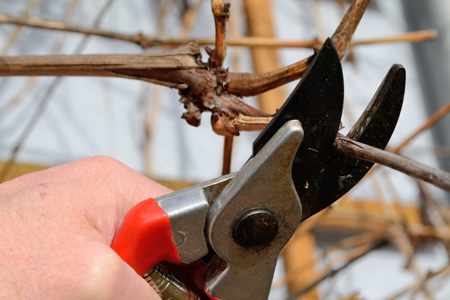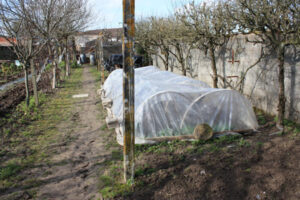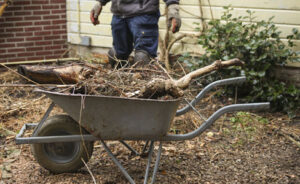- Shop
- Apparel
- Berries
- Books
- Bundles
- Citrus
- Fertilizer & Pest Control
- Fruiting Ground Covers
- Fruiting Shrubs
- Fruiting Trees
- Herbs, Spices, and Teas
- Mason Bees
- Nitrogen Fixers and Companion Plants
- Northwest Natives
- Nut Trees
- Ornamentals & More
- Perennial Vegetables
- Rootstock
- Subtropical Fruits
- Tools
- Vines
- Xeriscape
- Sale Items
- Information
- Nursery News
- Contact Us
- My Account

Winter Tasks in Preparation for Spring
So far it’s been a rather mild winter for us here in the Pacific Northwest. The thermometer has rarely dipped below 32 degrees and we’ve been taking advantage of the mild temps by taking care of the many winter tasks and planting tough woody plants in our gardens and around the nursery. In some protected spots around town we’re even starting to see late winter flowers open and buds start to swell. And while we aren’t done with winter yet it’s certainly not too early to begin pruning many of your fruit trees and do some garden planning while the days are still short.
Winter offers us the time to reflect on last year’s growing season and pour over the seemingly infinite options in the nursery and seed catalogs as we prepare for the northern hemisphere to tilt towards the sun once more and bring us another season of growth. And in the spirit of diversity and progression we’ve added tons of new varieties to our catalog this spring with many more varieties on the way throughout summer.
But while you wait for the snow to melt and the soil to warm there are many things you can be doing to prepare for the coming growing season! The first of course is designing next year’s garden! Having a design for your gardens and edible landscapes makes the decision making process on what shrubs and trees you’ll need to fill any empty spaces much easier. It also allows you to potentially fit more plants in if you know where everything is going. And who doesn’t need just a little bit of extra space in the garden to fit that one special plant they’ve been searching everywhere to find a place for!

Depending on your climate late January and early February are excellent times to get your early greens started. Here in the Pacific Northwest the soil is often too saturated to be worked. Working saturated soils can destroy the soil’s structure but adding a simple garden cloche, row cover, or PVC-crafted miniature hoop house can help your soil warm up much faster and keeps the rainwater from saturating it. Many seeds such as spinach, carrots, alliums and brassicas can be started once soil temperatures reach the high 40’s or 50’s. Vegetables, especially greens, grown in cool soils are often much sweeter and more tender than when they are grown in the full heat of summer. If you’ve never tried growing late winter greens give it a shot this year! There’s nothing better than lifting up your row cover or cold frame and harvesting a full salad of fresh greens from the backyard in late winter. A simple raised bed with PVC hoops and plastic cover can create a miniature greenhouse for growing all the cold season greens you could ever need! One Green World is now carrying a diverse array of vegetable seeds grown by Siskiyou Seeds in Southern Oregon that are incredibly well adapted to the cold and moist conditions typical of a Pacific Northwest spring. They are available at our retail location in SE Portland.
January can also be a great time to start pruning your fruit trees. In many areas it is still too cold, but gardeners in southern and mild coastal climates may already see signs of their trees breaking dormancy by late January or early February. A late winter pruning just before the trees break dormancy allows for the tree to heal any pruning wounds quickly without wasting any of its precious sugars on buds and branches that will be cut off anyways. If you have any trees you are planning on removing entirely January is a great time for that as well. Have any cut trees chipped and save the chips to be used as mulch in the spring.
There are also a few species that we recommend not pruning in winter and waiting until summer to prune. These include cherries, peaches, nectarines, apricots and sometimes plums. These species are so disease prone in our area that we often wait until the drier months to prune and create any open wounds. The hope is that they heal over as much as possible in dry weather and limit the chances of them becoming a disease vector. But certainly if you are pruning for scion wood then January is a great time to make those cuts.
Check your vegetable seeds viability! Remember those heirloom tomato seeds that you got at that seed exchange years ago? Well you can test to make sure they are still viable by taking a few of them and seeing if they germinate in warm indoor conditions. By checking your stored seed’s viability now you can avoid wasting time in the spring sowing seeds that are no longer viable.
Take cuttings for vegetative propagation. Late winter is a great time to take cuttings from many different species that you can use for rooting and grafting. You can even give them a start indoors or in the greenhouse and have a plant that’s large enough to be planted out come late spring or fall.

Sharpen your tools and sharpen your mind. With the lull in plant activity during the winter months you should have plenty of time to sharpen up those dulling pruners, replace the bolts on your wobbly wheelbarrow and be fully ready to go when the warm days of spring return. It is also a wonderful time for digging into books and learning something new. With One Green World’s exciting new selection of books you should have no trouble finding excellent reading material to dig into this winter.
